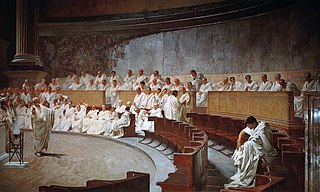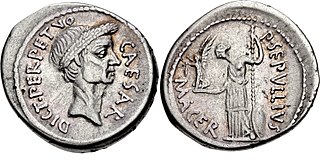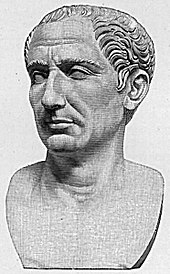
The cursus honorum was the sequential order of public offices held by aspiring politicians in the Roman Republic and the early Roman Empire. It was designed for men of senatorial rank. The cursus honorum comprised a mixture of military and political administration posts; the ultimate prize for winning election to each "rung" in the sequence was to become one of the two consuls in a given year. Each office had a minimum age for election; there were also minimum intervals between holding successive offices and laws forbade repeating an office.

The Senate was the governing and advisory assembly of the aristocracy in the ancient Roman Republic. It was not an elected body, but one whose members were appointed by the consuls, and later by the censors. After a Roman magistrate served his term in office, it usually was followed with automatic appointment to the Senate. According to the Greek historian Polybius, the principal source on the Constitution of the Roman Republic, the Roman Senate was the predominant branch of government. Polybius noted that it was the consuls who led the armies and the civil government in Rome, and it was the Roman assemblies which had the ultimate authority over elections, legislation, and criminal trials. However, since the Senate controlled money, administration, and the details of foreign policy, it had the most control over day-to-day life. The power and authority of the Senate derived from precedent, the high caliber and prestige of the senators, and the Senate's unbroken lineage, which dated back to the founding of the Republic in 509 BC. It developed from the Senate of the Roman Kingdom, and became the Senate of the Roman Empire.

The legislative assemblies of the Roman Republic were political institutions in the ancient Roman Republic. According to the contemporary historian Polybius, it was the people who had the final say regarding the election of magistrates, the enactment of Roman laws, the carrying out of capital punishment, the declaration of war and peace, and the creation of alliances. Under the Constitution of the Roman Republic, the people held the ultimate source of sovereignty.

A Roman dictator was an extraordinary magistrate in the Roman Republic endowed with full authority to resolve some specific problem to which he had been assigned. He received the full powers of the state, subordinating the other magistrates, consuls included, for the specific purpose of resolving that issue, and that issue only, and then dispensing with those powers immediately.

The Conflictof the Orders, sometimes referred to as the Struggle of the Orders, was a political struggle between the plebeians (commoners) and patricians (aristocrats) of the ancient Roman Republic lasting from 500 BC to 287 BC in which the plebeians sought political equality with the patricians. It played a major role in the development of the Constitution of the Roman Republic. Shortly after the founding of the Republic, this conflict led to a secession from Rome by Plebeians to the Sacred Mount at a time of war. The result of this first secession was the creation of the office of plebeian tribune, and with it the first acquisition of real power by the plebeians.

The senatus consultum ultimum is the modern term given to resolutions of the Roman Senate lending its moral support for magistrates to use the full extent of their powers and ignore the laws to safeguard the state.

The Curiate Assembly was the principal assembly that evolved in shape and form over the course of the Roman Kingdom until the Comitia Centuriata organized by Servius Tullius. During these first decades, the people of Rome were organized into thirty units called "Curiae". The Curiae were ethnic in nature, and thus were organized on the basis of the early Roman family, or, more specifically, on the basis of the thirty original patrician (aristocratic) clans. The Curiae formed an assembly for legislative, electoral, and judicial purposes. The Curiate Assembly passed laws, elected Consuls, and tried judicial cases. Consuls always presided over the assembly. While plebeians (commoners) could participate in this assembly, only the patricians could vote.

The Roman magistrates were elected officials in Ancient Rome.

The constitution of the Roman Republic was a set of uncodified norms and customs which, together with various written laws, guided the procedural governance of the Roman Republic. The constitution emerged from that of the Roman kingdom, evolved substantively and significantly—almost to the point of unrecognisability—over the almost five hundred years of the republic. The collapse of republican government and norms beginning in 133 BC would lead to the rise of Augustus and his principate.

The Roman Constitution was an uncodified set of guidelines and principles passed down mainly through precedent. The Roman constitution was not formal or even official, largely unwritten and constantly evolving. Having those characteristics, it was therefore more like the British and United States common law system than a sovereign law system like the English Constitutions of Clarendon and Great Charter or the United States Constitution, even though the constitution's evolution through the years was often directed by passage of new laws and repeal of older ones.

The Roman Assemblies were institutions in ancient Rome. They functioned as the machinery of the Roman legislative branch, and thus passed all legislation. Since the assemblies operated on the basis of a direct democracy, ordinary citizens, and not elected representatives, would cast all ballots. The assemblies were subject to strong checks on their power by the executive branch and by the Roman Senate. Laws were passed by Curia, Tribes, and century.

The executive magistrates of the Roman Republic were officials of the ancient Roman Republic, elected by the People of Rome. Ordinary magistrates (magistratus) were divided into several ranks according to their role and the power they wielded: censors, consuls, praetors, curule aediles, and finally quaestor. Any magistrate could obstruct (veto) an action that was being taken by a magistrate with an equal or lower degree of magisterial powers. By definition, plebeian tribunes and plebeian aediles were technically not magistrates as they were elected only by the plebeians, but no ordinary magistrate could veto any of their actions. Dictator was an extraordinary magistrate normally elected in times of emergency for a short period. During this period, the dictator's power over the Roman government was absolute, as they were not checked by any institution or magistrate.

The History of the Roman Constitution is a study of Ancient Rome that traces the progression of Roman political development from the founding of the city of Rome in 753 BC to the collapse of the Western Roman Empire in 476 AD. The constitution of the Roman Kingdom vested the sovereign power in the King of Rome. The king did have two rudimentary checks on his authority, which took the form of a board of elders and a popular assembly. The arrangement was similar to the constitutional arrangements found in contemporary Greek city-states. These Greek constitutional principles probably came to Rome through the Greek colonies of Magna Graecia in southern Italy. The Roman Kingdom was overthrown in 510 BC, according to legend, and in its place the Roman Republic was founded.

The Constitution of the Roman Empire was an unwritten set of guidelines and principles passed down mainly through precedent. After the fall of the Roman Republic, the constitutional balance of power shifted from the Roman Senate to the Roman Emperor. Beginning with the first emperor, Augustus, the emperor and the Senate were theoretically two co-equal branches of government. In practice, however, the actual authority of the imperial Senate was negligible, as the emperor held the true power of the state. During the reign of the second emperor, Tiberius, many of the powers that had been held by the Roman assemblies were transferred to the Senate.

The executive magistrates of the Roman Kingdom were elected officials of the ancient Roman Kingdom. During the period of the Roman Kingdom, the Roman King was the principal executive magistrate. His power, in practice, was absolute. He was the chief executive, chief priest, chief lawgiver, chief judge, and the sole commander-in-chief of the army. He had the sole power to select his own assistants, and to grant them their powers. Unlike most other ancient monarchs, his powers rested on law and legal precedent, through a type of statutory authorization known as "Imperium". He could only receive these powers through the political process of a democratic election, and could theoretically be removed from office. As such, he could not pass his powers to an heir upon his death, and he typically received no divine honors or recognitions. When the king died, his power reverted to the Roman Senate, which then chose an Interrex to facilitate the election of a new king. The new king was then formally elected by the People of Rome, and, upon the acquiescence of the Roman Senate, he was granted his Imperium by the people through the popular assembly.

The executive magistrates of the Roman Empire were elected individuals of the ancient Roman Empire. During the transition from monarchy to republic, the constitutional balance of power shifted from the executive to the Roman Senate. During the transition from republic to empire, the constitutional balance of power shifted back to the executive. Theoretically, the senate elected each new emperor, although in practice, it was the army which made the choice. The powers of an emperor, existed, in theory at least, by virtue of his legal standing. The two most significant components to an emperor's imperium were the "tribunician powers" and the "proconsular powers". In theory at least, the tribunician powers gave the emperor authority over Rome's civil government, while the proconsular powers gave him authority over the Roman army. While these distinctions were clearly defined during the early empire, eventually they were lost, and the emperor's powers became less constitutional and more monarchical.

The history of the Constitution of the Roman Republic is a study of the ancient Roman Republic that traces the progression of Roman political development from the founding of the Roman Republic in 509 BC until the founding of the Roman Empire in 27 BC. The constitutional history of the Roman Republic can be divided into five phases. The first phase began with the revolution which overthrew the Roman Kingdom in 509 BC, and the final phase ended with the revolution which overthrew the Roman Republic, and thus created the Roman Empire, in 27 BC. Throughout the history of the Republic, the constitutional evolution was driven by the struggle between the aristocracy and the ordinary citizens.

The history of the constitution of the Roman Empire begins with the establishment of the Principate in 27 BC and is considered to conclude with the abolition of that constitutional structure in favour of the Dominate at Diocletian's accession in AD 284.

The Centuriate Assembly of the Roman Republic was one of the three voting assemblies in the Roman constitution. It was named the Centuriate Assembly as it originally divided Roman citizens into groups of one hundred men by classes. The centuries initially reflected military status, but were later based on the wealth of their members. The centuries gathered into the Centuriate Assembly for legislative, electoral, and judicial purposes. The majority of votes in any century decided how that century voted. Each century received one vote, regardless of how many electors each Century held. Once a majority of centuries voted in the same way on a given measure, the voting ended, and the matter was decided. Only the Centuriate Assembly could declare war or elect the highest-ranking Roman magistrates: consuls, praetors and censors. The Centuriate Assembly could also pass a law that granted constitutional command authority, or "Imperium", to Consuls and Praetors, and Censorial powers to Censors. In addition, the Centuriate Assembly served as the highest court of appeal in certain judicial cases, and ratified the results of a Census.

The Constitutional reforms of Augustus were a series of laws that were enacted by the Roman Emperor Augustus between 30 BC and 2 BC, which transformed the Constitution of the Roman Republic into the Constitution of the Roman Empire. The era during which these changes were made began when Augustus defeated Mark Antony and Cleopatra at the Battle of Actium in 31 BC, and ended when the Roman Senate granted Augustus the title "Pater Patriae" in 2 BC.






